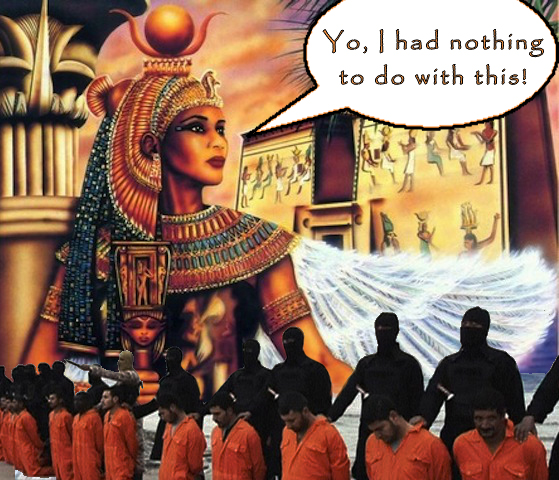Until recently, when I used the term “Isis cult†I had in mind the once-popular religion of Isis and Osiris, a faith originating in archaic Egypt, then spreading throughout the Roman Empire. It was a major religion when Christianity was just getting started with small groups meeting in local Moose Lodges. But now, of course, the term refers to the religio-political nightmare known as The Islamic State in Syria (and the Levant). They are insane savages, to put it mildly. One can scarcely imagine a more depraved bunch. They seek to exterminate Jews, Christians, Yezidis, Shi’ites, and any Sunnis who commit the mortal sin of disagreeing with them. They crucify and behead unbelievers. They rape women and girls, seeing these atrocities as by no means inconsistent with the moral ideals of their religion. They do their best to murder the pre-ISIS past, warring against the cultural heritage of the Middle East and the West, demolishing ancient Assyrian relics and promising to level the Pyramids of Egypt. It is hard to understand such religious and moral perversion, as if these maniacs had prayed the prayer of Gilles de Rais (the historical Bluebeard): “Evil, be thou my good!â€
But it is even harder to understand what motivates young Muslims in America and Western Europe to drop what they’re doing and buy a plane ticket to Pandaemonium. In biblical terms, it’s as if it was Satan who appeared on the Galilean shore, bidding Peter, Andrew, and the sons of Zebedee to leave their nets and follow him, and they did.
In some ways, there are parallels to the great “cult†hysteria of the 1970s. Then, too, we heard about seemingly normal young people, none of them particularly deprived, unstable, or uneducated, who walked off good jobs and abandoned degree programs to march to the tune of Reverend Moon, the Hare Krishna sect, the Tony & Susan Alamo Foundation, the Children of God, etc., etc. Of course, the big difference is that none of these groups was violent. I know what you’re thinking: what about Jim Jones and the People’s Temple? Keep in mind that Jones did not send his people to engage in acts of violence. Politically, the People’s Temple was a pretty sophisticated Liberal activist group. Their violence was a spasm of self-annihilation. Ditto David Koresh’s Branch Davidian commune. The Manson Family, on the other hand, was a genuine exception.
What is a “cultâ€? There are two criteria. Neither is necessary, but either is sufficient. Often both are present. First, a cult is a (new) religious movement transplanted from a different culture, e.g., the Unification Church (“Mooniesâ€) and the International Society for Krishna Consciousness (a missionary effort of a Hindu devotional (bhakti) sect dating back to 14th century India). Second, there is complete control, voluntarily embraced, over the lives of the adherents, exerted by the leader himself or by a pyramid of deputies if the cult is large enough. Reverend Moon matched and married couples he had never met and who likely did not know each other. (I attended two of their mass weddings in Madison Square Garden.) Jim Jones dissolved married couples and matched them with new mates.
As far as I can tell, none of the notorious cults of the 70s actually coerced, brainwashed, or forcibly isolated members from their families. These accusations were born of a lack of understanding by outsiders as to what attracted individuals to join these groups and to render such absolute dedication. (Or maybe not so absolute: the typical turnover rate for cults was over 90 per cent!) Concerned parents, pundits, etc., were in effect saying, “I can’t imagine joining a cult unless I got hypnotized or brainwashed!†They just didn’t get it, any more than most today can fathom the motivation of young people who up and join ISIS.
But I think it is a mystery with a solution. I believe the late fundamentalist Presbyterian Francis A. Schaeffer hit the bull’s eye in his 1972 booklet The New Super-Spirituality. He was discussing the earlier hyper-fundamentalist Christian groups like the Alamos and the Children of God. These groups made no secret of their contempt for mainstream evangelical churches and ministries. The COG, for example, would send into Sunday morning church services their own members clad in sackcloth and ashes, stamping wooden staves on the sanctuary floor, chanting verses of judgment and doom. It was a classic case of a repeating historical pattern described by sociologist Max Weber: sects begin by rejecting “worldly†religious institutions which have betrayed their founders’ radical, counter-cultural vision. But in a generation or so, as these Young Turks have children and assimilate to the societal norms they once repudiated, the sect becomes a church, and after a while the whole thing begins again.
Schaeffer was sectarian in one sense: at some of his lectures (I heard one of them at Princeton University chapel), he would stamp his feet and shout “We are the true Bolsheviks!†But in The New Super-Spirituality, he theorized that a new generation of Christian youth, raised on Sunday bombast about taking up one’s cross to follow Jesus, were disillusioned by the complacent piety of their pew-potato parents and decided to chuck the affluent American lifestyle and put their money where their mouths were. They sought out Christian communes (I visited some of them: Reba Place Fellowship, Sojourners, Jesus People USA, Christian World Liberation Front), pooled possessions, took Bible names, and spent hours each day witnessing, praying, and reading scripture. All in the advancing shadow of the Second Coming.
I think we are witnessing pretty much the same thing with young Muslims leaving the West and heading for the Islamic State. You have to understand that the whole Jihad movement is a reaction against centuries of theologically devastating Islamic humiliation. In the early centuries Islam ruled an empire larger than the Roman Empire was at its height. This success could not but be experienced by Muslims as living confirmation of their belief that they were pioneers and inheritors of the Kingdom of Allah on earth. Thus when their empire began to fade, to fragment, and ultimately to face defeat, even domination, by Christian and secular powers, it was Allah’s own reputation that was impeached. It was no mere frustration; it was an existential threat to the religion: “then your faith is in vain†(1 Corinthians 15:14).
The eventual (and predictable) result was a Revitalization Movement (Anthony Wallace). When a traditional culture (and thus religion) is threatened by conquest or colonization, many will acquiesce, but some will resist, absorbing elements from the outsiders which had given them a tactical advantage (sometimes including elements of the conquerors’ religion, but not necessarily). In short, the partisans of the old ways will try to turn their enemies’ weapons against them. This accounts for the happy willingness of Islamists to embrace Western technology like Social Media (not to mention weaponry) to promote a return to the norms of the seventh century. Sort of like that Star Trek episode where, on a parallel world, the Roman Empire never fell and the Roman legionaries used machine guns and televised gladiator matches.
I believe Islamic young people in the West (some of them) find themselves in the same position as the disappointed evangelical youth Schaeffer described. What they heard in their mosques about Muhammad and the past glories of Islam sounded antithetical to the pluralism and secularism of the society around them. Pluralism inevitably dissolves any master narrative that may once have given a more monolithic society its identity and sense of direction. For Muslims, their very existence as one more plant in a larger garden seems to contradict the ostensible raison d’être of Islam. The blandishments of radical Islam offer what a secular, pluralistic society cannot give: a jihad to conquer anomie.
Let’s turn to the question of the mad violence of Islamist militants. What accounts for this? Peter L. Berger and Thomas V. Luckmann offer the clue to this one. The Islamists, as they know full well, are totally at odds with the modern, secular, religiously diverse world. They face criticism from all sides for their advocacy of ancient Shariah law. Even the very existence of alternative opinions is a threat, since the mere fact that other worldviews are possible (and actual) must raise questions: “They seem pretty convinced, too! How can I be sure we’re right?†Traditionally, dogmatic religions try to set their members’ minds at ease using “legitimation†strategies, seeking to defend, e.g., the accuracy of the Bible, the resurrection of Jesus. They may caricature or slander competing faiths. It might be bad manners, but nobody ends up bleeding.
Evangelism serves as another legitimation strategy. The more people one can persuade to join one’s religion, the more votes one can count toward the truth of one’s belief. One’s faith is buttressed by one’s membership in a “plausibility structure,†a matrix of people who share one’s beliefs, values, and assumptions. The peer support makes the shared beliefs seem self-evidently true. After all, “everyone†thinks so, right? A believer may seek to keep unbelievers (or other-believers) at arm’s length, since at close quarters their lack of faith in your creed might tend to undermine your faith in it. For instance, interfaith marriage is sure to erode either spouse’s faith.
The Isis legitimation strategy is in principle the same as evangelism and high-walled parochialism, only it is much fiercer. Here one seeks to remove from the very earth any and all who do not share the true faith. The goal is to make radical Islam self-evidently true and impossible to doubt. The very existence of dissenters and doubters constitutes aggression against which the ansaru Allah (helpers of Allah) must “defendâ€â€”by annihilating them. The women, like their men, do not even count as humans anymore, so pious Muslims may rape them (one may add, like goats).
Even the “pagan†past must go, as Islamist fanatics seek to erase any evidence that the world was ever anything but Muslim. It is like the fundamentalist hatred for dinosaur fossils, the very existence of which allows and demands a version of history and paleontology inconsistent with the Bible.
 Some politicians urge us to pause a moment and try to understand our enemies. I think I do understand them, and that understanding does nothing to soften my total and complete antipathy to the Isis savages. In fact, it only makes it worse.
Some politicians urge us to pause a moment and try to understand our enemies. I think I do understand them, and that understanding does nothing to soften my total and complete antipathy to the Isis savages. In fact, it only makes it worse.
One point at which ISIS does not parallel the cults of the 1970s is that business about the turnover rate. The idealistic kids who heed the call of Islamism are not likely to be able to return home once they start having second thoughts.
So says Zarathustra.


4 Responses to The Isis Cult